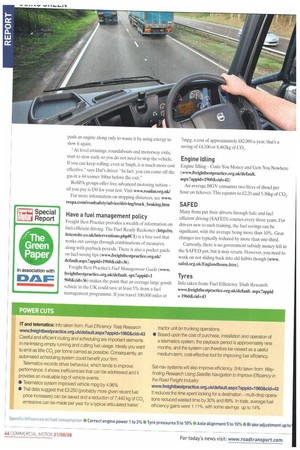POWER CUTS
Page 46

If you've noticed an error in this article please click here to report it so we can fix it.
IT and telematics: Info taken from: Fuel Efficiency Trials Research www.treightbestpractice.org.uk/defaultaspx?appick1960&cid=43 Careful and efficient routing and scheduling are important elements in minimising empty running and cutting fuel usage. Ideally you want to emit as little CO, per tonne carried as possible. Consequently, an automated scheduling system could benefit your firm.
Telematics records driver behaviour, which tends to improve performance; it shows inefficiencies that can be addressed and it provides an invaluable log of vehicle events.
• Telematics system improved vehicle mpg by 4.96% • Trial data suggest that £3,250 (probably more given recent fuel price increases) can be saved and a reduction of 7,440 kg of CO, emissions can be made per year for a typical articulated trailer/ tractor unit on trunking operations.
• Based upon the cost of purchase, installation and operation of a telematics system, the payback period is approximately nine months, and the system can therefore be viewed as a useful medium-term, cost-effective tool for improving fuel efficiency
Sat-nay systems will also improve efficiency. (Info taken from: Wayfinding Research Using Satellite Navigation to Improve Efficiency in the Road Freight Industry www.freightbestpractice.org.uWdefaultaspx?appid=1960&cid=43 It reduces the time spent looking for a destination multi-drop operations reduced wasted time by 30% and 89%. In trials, average fuel efficiency gains were 1.11%, with some savings up to 14%












































































































































































